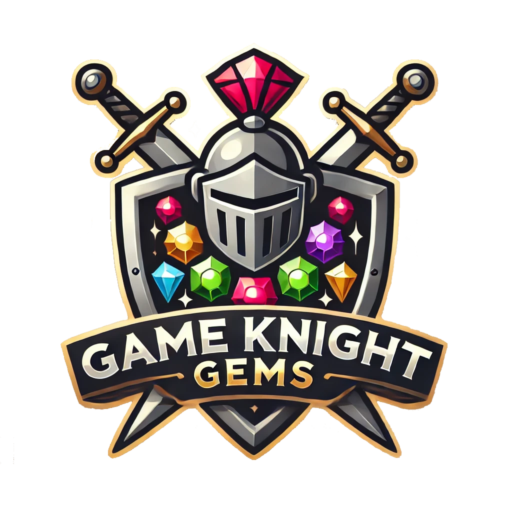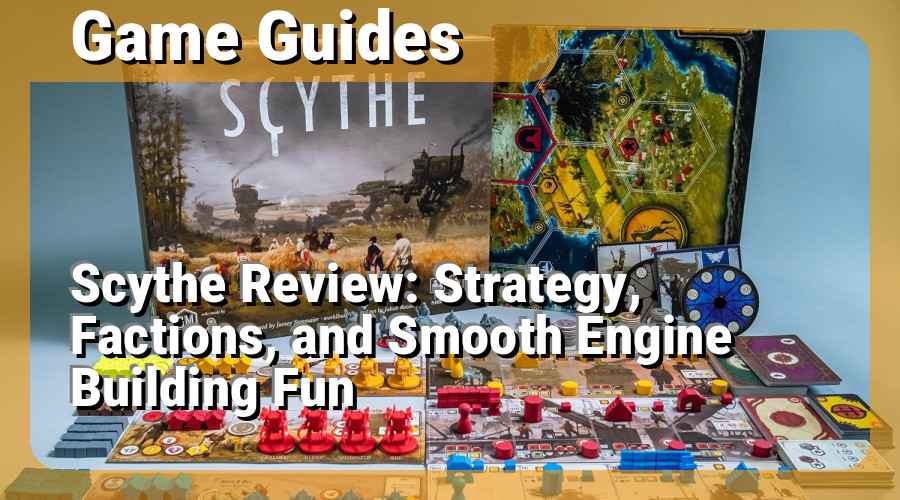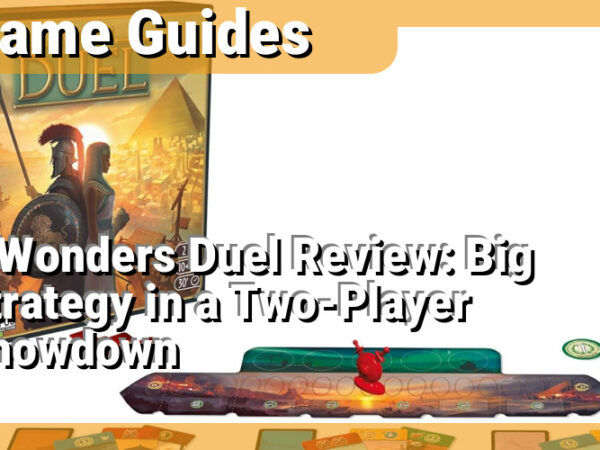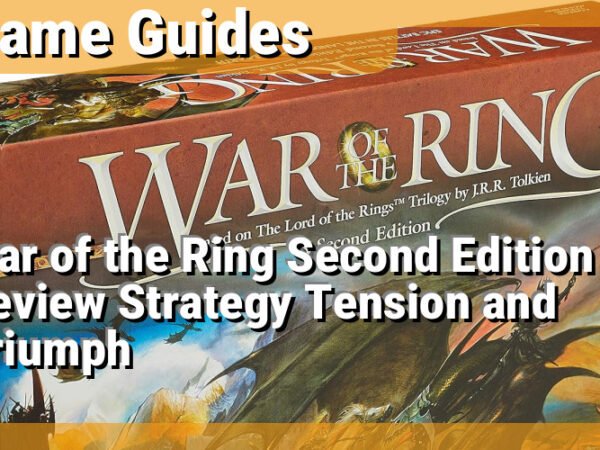Posts may contain affiliate links. Learn more in our Affiliate Link Policy.
Where to Buy Scythe: Amazon US | Amazon CA
How to Play Scythe: A Simple Step-by-Step Guide
Scythe is a big-box strategy game filled with mechs, resources, and choices that stack up fast. It looks intense at first glance, but once you know the basics, it all flows smooth. If you’re the one getting this to the table for the first time, I’ve got your back. Let’s break it down so you can teach your group with confidence and get started without flipping through the rulebook every five minutes.
What’s Scythe About?
Scythe is a 1 to 7 player game set in an alternate 1920s Europe. Think steam-powered robots and farmers in the same field. Each player controls a different faction with its own abilities, trying to gain power and popularity while collecting resources, building mechs, and finishing objectives.
The game ends when a player places their sixth star on the Triumph Track, but winning comes down to total money, not who places stars fastest. That means smart planning beats rushing to the finish.
What You Need to Set Up
Before you start, here’s what you need out on the table:
- The main board
- Faction mats (randomly dealt)
- Player mats (randomly dealt)
- Miniatures, tokens, and starting resources based on your faction
- The 6 structure bonus tiles (choose one at random for this game)
- Objective cards (2 per player, keep 1)
- Combat cards, shuffled
- Encounter tokens (placed on the board with the green symbol)
- Factory cards, shuffled
Each player starts on their faction’s home base with some coins, workers, and maybe resources, depending on the faction. Mechs and buildings go on your faction mat. Stars, popularity, and power are marked on the board.
Goal of the Game
You’re trying to have the most money at the end. You earn coins by doing smart stuff like:
- Completing objectives
- Winning battles
- Building all your mechs
- Maxing out power or popularity tracks
- Building structures
All of these actions put stars on the board. When someone hits six stars, the game ends—but total coins still decide who wins.
Your Turn: Four Simple Sections
Your turn is always just one move. You pick one of the four sections on your player mat and do the top action and/or bottom action listed there. That’s it.
You can’t pick the same section as last turn, so keep that in mind while planning ahead. Each section has a top action (usually free) and a bottom action (costs something but gives better rewards).
Top Actions
These are what you usually do first. You can:
- Move: Move units across the board—one hex at a time. Workers can move with resources. You can’t move through rivers unless you unlock Riverwalk with a mech. Oh, and no two players can share a space.
- Bolster: Gain 1 power or draw 1 combat card; either way, pay 1 coin.
- Produce: Choose 2 different hexes you control and produce stuff there (workers, metal, food, oil, or wood based on the space).
- Trade: Pay 1 coin to gain any 2 resources or popularity.
Bottom Actions
You always check if you can pay the cost. If you can and want to, go for it. These cost stuff but give big returns:
- Upgrade: Pay 3 oil to move a cube from the top row to the bottom row. This makes a top action stronger and a bottom action cheaper. This is a huge deal for your long-term engine.
- Deploy: Pay metal to build a mech. Move it from your board to a hex you control with a worker. Each mech you deploy unlocks a new ability like Riverwalk or Speed.
- Build: Pay wood and place one of your buildings on the board. Each building gives you a perk and helps with end-game scoring.
- Enlist: Pay food to remove a recruit token from your board. You get a one-time bonus and ongoing abilities when neighbors do bottom actions. Plus, it connects another benefit to your engine.
Combat
Combat is simple and sneaky. When you move into a space that has another player’s unit (worker or mech or character), combat kicks off. Each player:
- Selects power on the combat dial (up to 7)
- Adds 0 to 2 combat cards (only if a mech or character fights)
Then reveal. Highest total wins. Ties go to the attacker. The loser’s mechs or character go back to their home base (no permanent destruction). If workers lose, they return too, and the attacker loses popularity for each worker there.
Encounters
If your character (only the character, not mechs) moves onto a space with an encounter token, you draw a card and choose from three mini-story options. These usually offer a quick reward, sometimes at a moral or mechanical cost. You get to choose your playstyle here—aggressive, helpful, resourceful. The encounter marker is removed afterward.
The Factory
The Factory is the big hex in the middle of the map. The first player who gets their character there chooses one Factory card (get there early for better options). Each Factory card gives you a special 5th action spot that only you have access to. Powerful stuff, smartly played.
How the Game Ends
The game ends immediately when one player places their sixth star on the Triumph Track. You can earn a star for doing any of the following:
- Win a combat (up to 2 stars)
- Complete an objective
- Max out your popularity
- Max out your power
- Deploy all four mechs
- Build all your structures
- Enlist all your recruits
- Upgrade all cubes
Scoring
Count up coins at the end to find the winner. Here’s how coin values are calculated:
- Stars: Worth 3, 4, or 5 coins each depending on your popularity level
- Controlled territories: One coin per territory, value based on popularity
- Resources you control: Every 2 resources = 1 coin, also based on popularity
- Structures: Depending on the bonus tile, extra money
Popularity makes everything better during scoring, so boosting that track matters more than some folks realize on their first run.
Sam’s Tips for Teaching Scythe
- Skip full faction overviews at the start—just highlight unique abilities as you play
- Walk through one full sample turn before free play begins
- Remind players often they can only use a section once per turn, not repeat it next turn
- Tell folks to plan for balance: Upgrades and enlists turbocharge your engine
- Playing aggressively earns stars, not coins—don’t chase fights just to fight
Final Thoughts on First-Time Play
Don’t worry if the first game takes a little longer. Scythe has a lot going on, but it feels much more natural than it looks. After a couple rounds, turns move quickly. Everyone will start seeing how their engine unfolds, when to go for a star, or how to pile up coins behind the scenes.
Whether you’re building fast, going for control, or engineering the perfect combat timing, Scythe gives you room to play your way—just don’t forget to check the money before assuming you’re winning. And once you’ve got a crew that knows it, games can be tight, tense, and smooth inside 90 minutes.
Now shuffle those combat cards, pick your faction, and get that first mech on the board. You’ve got a Scythe game to run.





